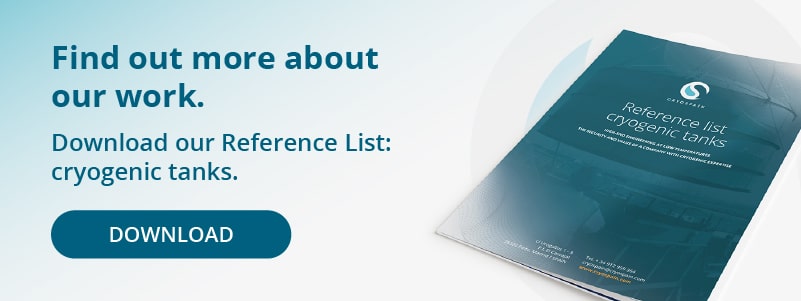Oxygen presents numerous uses across different sectors, a wide variety of functionalities that also mean there’s a pressing need for many industries to store this element. Liquid oxygen tanks have become one of the most efficient methods to do so.
We analyse what industries are typically in need of liquid oxygen, how LOX tanks work and the potential alternatives for liquid oxygen storage.
Different uses of liquid oxygen
Liquid oxygen is the liquid form of molecular oxygen. It is obtained from oxygen found naturally in air, by means of a cryogenic plant or by applying fractional distillation, and was first used in 1926 as a rocket fuel. It is slightly denser than liquid water and cryogenic, with a boiling point of −182.96 °C at 1 bar (15 psi) and a freezing point of −218.79 °C.
Liquid oxygen is widely used across multiple sectors, including the medical and pharmaceuticals industries (providing oxygen therapy, among other important uses) and the aerospace industry (for instance, for high-altitude aircraft flights).
Related article: Designing a medical oxygen plant: everything you need to know
Liquid oxygen on the industries
- Steel manufacturing uses liquid oxygen to generate combustion temperatures and enrich air, as well as combustible for steel making.
- The metal production industry works with liquid oxygen in order to increase combustion temperatures and replace or enrich air.
- The pulp and paper industry need liquid oxygen for bleaching, delignification, or oxidative extraction, among other processes.
- Chemical industries employ liquid oxygen to generate oxidation processes that help alter feedstock structure.
- Liquid oxygen also plays a role in petroleum refining and recovery, improving flow and reducing viscosity, among other important functions.
Storing liquid oxygen
Liquid oxygen tanks
LOX tanks or liquid oxygen tanks provide a typical system for the storage of liquid oxygen.
Liquid oxygen tank sizes can vary according to each project’s needs, and the most simple system includes a double wall for insulation and a single containment, so that the liquid oxygen is contained within an inner tank.
This way, only the inner tanks need to comply with requirements for low temperatures. These tanks are generally insulated using perlite and inert gases such as nitrogen.
There are a number of norms and international certificates that regulate liquid oxygen tanks, including:
- Regulations for mechanical and seismic design such as API620, API650, ASME, EN14620, EN14015 and EUROCODE.
- Regulations for external access, including EN ISO14122-1/3 and OSHA 1910.23/24
- Other regulations, such as EIGA/CGA/127/13/E and NFPA 59A.
Keep learning: Importance of liquid oxygen systems in the medical and pharmaceutical industry
Storing alternatives
While liquid oxygen tanks are the preferred option for a number of industries, there are other alternatives.
- A pressurized oxygen tank can be used for industrial processes, welding or medical gas.
- Chemical oxygen generators allow for the storage of oxygen, although they can only be used one time for this purpose. This is the choice for some commercial airlines which need emergency oxygen generators.
- Some chemical compounds reversibly release oxygen when heated or being submitted to pressure changes.
Is your company looking for the best alternative to store liquid oxygen and have you been considering LOX tanks?
At Cryospain, we design and implement liquid oxygen tanks with double-wall steel structures using high tech insulating materials such as cellular glass, expanded perlite, rockwool, etc. Through our decades-long expertise, we’re able to provide safe systems for cryogenic storage equipment, while complying with the most recognized quality and safety certificates on an international level.
We’re also able to facilitate different liquid oxygen tank sizes, all according to our clients’ needs. This was the case of our success story for liquid oxygen storage project in Houston (Texas), where we built a 3,160m³ liquid oxygen storage tank while also taking into account several challenges related to the environment.
Get in touch with us and we’ll talk about the best options for your liquid oxygen tanks’ needs.











 Contacte-nos
Contacte-nos